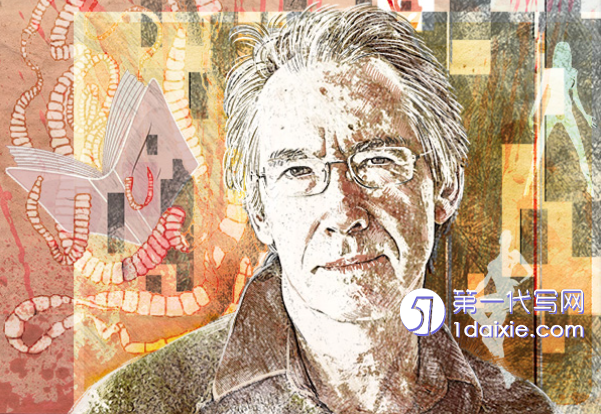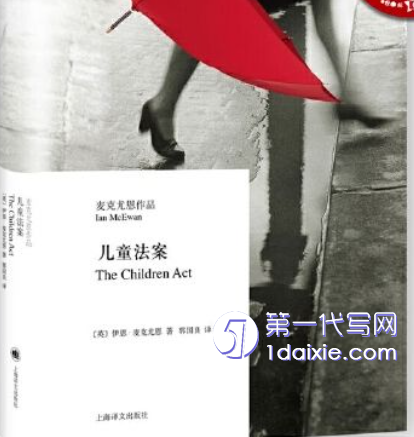本文是一篇英语论文,笔者认为《儿童法案》是英国当代最有影响力的英国作家之一伊恩·麦克尤恩发表于2014年的小说,该小说探讨了奴隶心态与主人心态、法律与宗教、情感与理性之间的紧张与冲突,呈现了这些冲突造成的后果,并最终以救赎失败告终。
I. Introduction
A. Ian McEwan and The Children Act

As a productive writer, Ian McEwan has published short stories, screenplays, and long novels since 1975, and the focus of his writing has undergone many changes over the following years. At first, his works were characteristic of disturbing themes of sexual perversion, and it also earned him the nickname “Ian Macabre.” His two collections of Gothic short stories—First love, Last Rites (1975) and In Between the Sheets, and Other Stories (1978)—deal with sexual perversity and peculiarities. And his first novel, The Cement Garden (1979), also deals with a similar topic, which discusses the abnormal relationship between a sister and a brother. The Comfort Strangers (1981) is about sadistic sexual problems. At the same time, these short stories show that McEwan has focused on human nature in his early creation, which also lays the direction of McEwan’s future writing. After creating short stories, he begins to write screenplays. His main representatives of screenplays include The Imitation Game: Three Plays for Television (1981), Or Shall We Die? (1983), The Ploughman’s Lunch (1985), Sour Sweet (1988), and For You (2008). These screenplays have the thematic depth that his early works lack.
His major literary achievement comprises the novels that have been published since the late 1980s. Those are The Child in Time (1987), The Innocent (1990), The Black Dogs (1992), Enduring Love (1997), Amsterdam (1998), Atonement (2001), Saturday (2005), On Chesil Beach (2007), Solar (2010), Sweet Tooth (2012), The Children Act (2014), Nutshell (2016) and Machines Like Me (2019).
B. Literature Review
After publishing Atonement, Ian McEwan has become an increasingly heated research subject in the literary field, and the critical attention towards his writing extends to his every work. When The Children Act is published, it becomes both a commercial and a critical success.
Guillermo Lartigue believes that the work reveals the problems of law and morality in his “Reasonable, Moral Conflict, and Tragedy in The Children Act”. Tamray Amiel Houser argues that McEwan intensifies the conflict and differentiation between reason and belief and explores the limits of rationality and the tragic conflict between reason and religion. Meanwhile, Ronald Soetaret and Kris Rutten take Saturday and The Children Act as examples to illustrate the controversy between art and science and dig into the controversial moral decisions.
Domestic studies of The Children Act mainly can be divided into several categories: narratological perspective, ethical perspective, psychoanalysis perspective, and other perspectives. From a narratological standpoint, Zhang Xian analyses the analepsis, prolepsis, and singular narrative events that McEwan has used in the light of Gerard Genette’s theory of narratology to reveal the character’s inner world and conflicts in modern society. Zhi Tingting and Wu Lanxiang discuss Fiona with the narrative theory of possible worlds developed by Marie-Laure Ryan, analyzing the internal disputes of Fiona’s wish world and its struggles with other possible worlds and subsequently uncovering the idea of Fiona’s activities and mental contentions.
II. Tensions and Conflicts in The Children Act
A. Slave Mentality and Master Mentality
In modern society, people indulge in automatic work and are obedient to authority, which leads to their depression of true feelings and slave mentality. In Beyond Good and Evil (1886), Nietzsche describes the fundamental division between the mentalities of the ‘herd’ and of ‘higher’ people. “I would add at once that in all higher and complex cultures, there are also apparent attempts to mediate between the two mentalities, and even more often a confusion of the two and a mutual misunderstanding… - even in the same person” (260). According to Nietzsche, master mentality includes everything advocated by him: “will to power,” the sincere attitude towards life, vigorous creative spirit, and great love for the future of mankind. On the contrary, slave mentality includes everything he opposes: weakness, cowardice, loss of personality, hypocrisy, conservatism, and resentment. As Lacewing contends that “noble people experience themselves as the origin of value, deciding what is good or not. ‘Good’ originates in self-affirmation, a celebration of one’s own greatness and power. They don’t need others to say they are good” (2). This self-affirmation is what is lacking in religious blindness and bigotry, as is portrayed in detail in the novel.
B. Irreconcilable Conflict Between Religion and Law
The binary opposition between religion and law emerges as a more complicated issue that seems beyond negotiation or compromise. People are used to claiming that the law deals with normal situations and promote the greatest happiness of the greatest majority according to the universal scope of various people concerned. On the other hand, religion is related to people’s need for moral norms beyond society, as well as their need to understand the meaning of life and fight against death. Therefore, it tends to oversimplify the public law as social behavior regulation and religion as private behavior restriction.
With the development of modernity, there has been an intensification of the role of law in public and a decline of the role of religion though it has been conspiring with politics and shared the governing for a long time. In a pluralistic society, both religion and law still have a place. In addition, there are an increasing number of legal cases involving religion that challenges the legal system and shakes the foundation of constitutional law. McEwan’s The Children Act focuses on a real-life conflict between religion and children’s rights and explores the conflicts between religion and law.
III. Aftermath of Tensions and Conflicts .................................. 20
A. Fear of Freedom ..................................... 21
B. One-Dimensional Man ..................................... 25
C. Maximization of Utility ............................... 29
IV. Failed Awakening of Value Rationality ..................................... 34
A. Salvation Through Music and Literature .............................. 35
B. Resentment and Self-destruction ........................... 39
Ⅴ. Conclusion.......................................... 44
IV. Failed Awakening of Value Rationality
A. Salvation Through Music and Literature
With the increasingly fierce competition in modern society, division of labor and mechanical work lead to human alienation. In order to adapt to the fast pace of modern life, people generally pay too much attention to instrumental rationality at the expense of value rationality. Although their material desires are easily satisfied, the spiritual vacuity and loss of purpose in life have loomed ever larger over the horizon. The solution to those spiritual crises has been repeatedly suggested in McEwan’s later novels, such as Atonement, Saturday, On Chesil Beach, and The Children Act, to be literature and art.
In his article, “Literature, Science, and Human Nature” (2005), McEwan asserts that “Literature flourishes along the channels of this unspoken agreement between writers and readers, offering a mental map whose north and south are the specific and the general. At its best, literature is universal, illuminating human nature at precisely the point at which it is most parochial and specific” (6). Literature is the mirror and lamp that can illuminate what human beings share and how the individual characterizes his traits and characteristics. Besides, the aesthetic experience of art may become a possible way to alleviate the spiritual crisis. According to Max Weber, art assumes the important function of providing meaning to life, and aesthetics has a redemptive function of rescuing people from the rationalistic repression of cognitive and moral activities. In McEwan’s recent novels, besides exploring the ethics and morality of modern society, analyzing the social problems of modern society, and calling on people to reflect on modern society, he also emphasizes the unique role of art in healing people’s hearts.

Ⅴ. Conclusion
As Charles Dickens illustrates in A Tale of Two Cities (1859): It was the best of times, it was the worst of times, it was the age of wisdom, it was the age of foolishness, it was the epoch of belief, it was the epoch of incredulity, it was the season of Light, it was the season of Darkness, it was the spring of hope, it was the winter of despair, we had everything before us, we had nothing before us, we were all going direct to Heaven, we were all going direct the other way—in short, the period was so far like the present period, that some of its noisiest authorities insisted on its being received, for good or for evil, in the superlative degree of comparison only. (7)
This is the best era because science and technology are changing with each passing day, and the economy is developing rapidly. While we are cheering for modernity, we should also pay attention to the various social maladies caused by modernity, and these maladies are alerting people that this is also the worst time. The survival environment faced by modern people seems to be unprecedentedly complex. As is illuminated in McEwan’s The Children Act, various tensions and conflicts become unavoidable and urgent. As a High Court judge, Fiona Maye metes out justice and settles the disputes, weighing the options to come up with the best solution to every case. However, out of court, she is unexpectedly mired in the entanglement of marital problems and the emotional involvement with a teenage boy who is in need of her guidance and help. She tries to be rational and keep everything in control, but her prudence and rationality backfire, resulting in the irredeemable consequences of Adam’s death.
reference(omitted)
